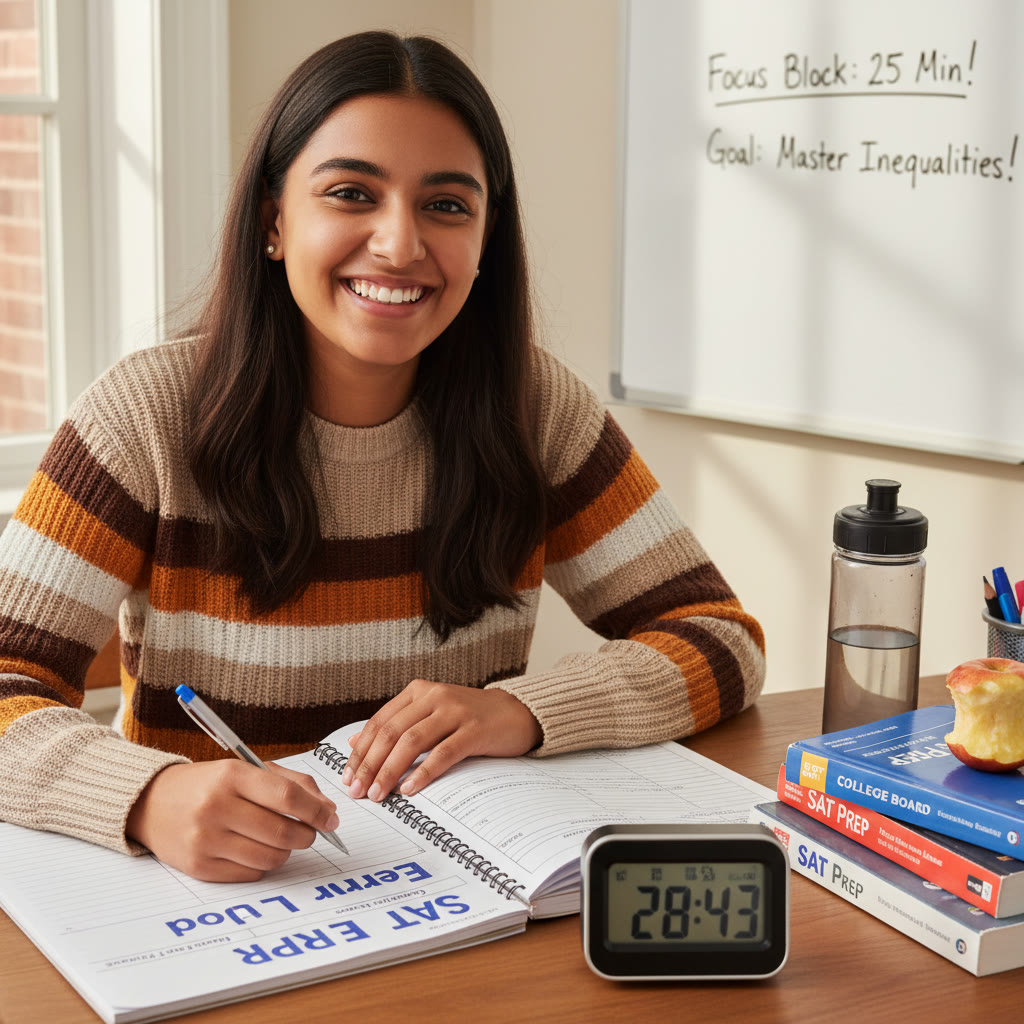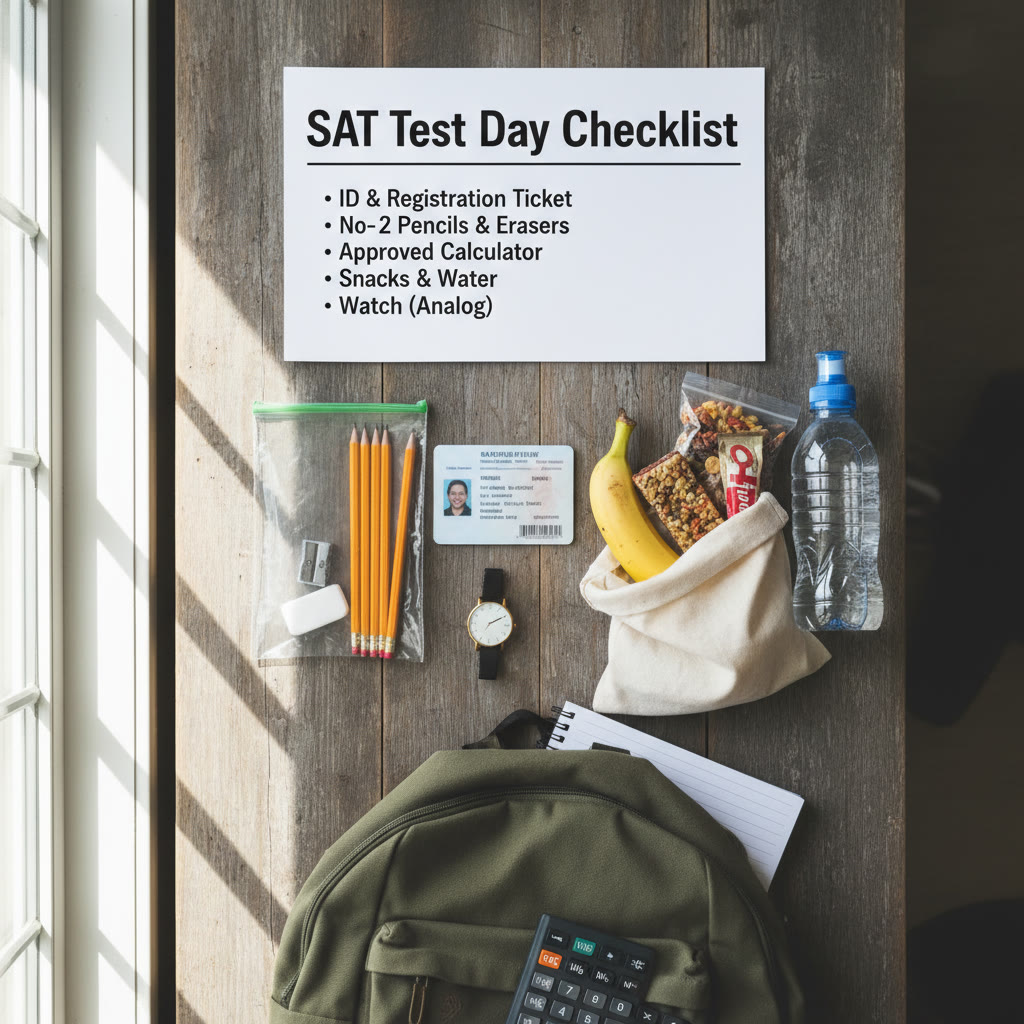Introduction: Study Less, Score More — The Case for Smart SAT Prep
There’s a persistent myth that long hours equal results. For the SAT, that’s only half true. What really matters is how you use your time. Ten focused, efficient hours can beat thirty aimless ones because the brain learns patterns, not just content. If your calendar feels like a battlefield between school, activities, and social life, welcome — this guide is for you. We’ll walk through 10 practical hacks that slice wasted minutes and amplify results, with real examples, a sample weekly plan, and one compact table showing how small gains compound into big savings.
These strategies are honest, human, and flexible. They’re built for busy students who want smarter work, not just more work. Along the way I’ll mention how Sparkl’s personalized tutoring can fit naturally into these habits — offering 1-on-1 guidance, tailored study plans, expert tutors, and AI-driven insights that keep you moving in the right direction.
Quick Overview: The 10 Hacks at a Glance
- Hack 1 — Start with a diagnostic and set one measurable goal.
- Hack 2 — Use ultra-focused, short study blocks (the 25–40 minute rule).
- Hack 3 — Prioritize weaknesses with targeted practice, not blind repetition.
- Hack 4 — Simulate realistic, timed sections to train rhythm.
- Hack 5 — Build an error log and study patterns, not individual mistakes.
- Hack 6 — Apply active learning techniques (teach, summarize, test).
- Hack 7 — Master the quick heuristics and question triage for test day.
- Hack 8 — Use high-quality resources and practice tests strategically.
- Hack 9 — Optimize logistics: sleep, snacks, timing, and the test environment.
- Hack 10 — Get the right help: guided tutoring and AI insights when you’re stuck.
Hack 1 — Start Smart: A Diagnostic + One Clear, Measurable Goal
Before you start drilling vocab lists or grinding problem after problem, take one full practice test under realistic conditions. This diagnostic gives you two things: a baseline score and a profile of where time leaks and mistake patterns happen. That intelligence prevents aimless practice.
Now make a single measurable goal. Not “get better,” but something like “raise Math by 60 points in 8 weeks” or “increase Reading score from 620 to 700.” Specific goals let you reverse-engineer the plan and track time spent against improvements — the quickest way to see if your approach actually saves time.
Tip: If you’re juggling schoolwork, Sparkl’s personalized tutoring can turn that baseline into an individualized plan. A tutor can interpret your diagnostic quickly and suggest which practice to skip and which to prioritize, saving weeks of trial-and-error.
Hack 2 — Short, Intense Study Blocks Beat Marathon Sessions
Long, unfocused study sessions often become glorified procrastination. Instead, adopt focused blocks: 25 to 40 minutes of deep work followed by a 5–10 minute break. This respects attention spans while maximizing retention.
- Use a timer. Commit to one uninterrupted block — no phone, no social media.
- Set a micro-goal for the block: “Complete 12 sentence-completion problems” or “drill geometry angle-chasing.”
- After each block, jot one sentence summarizing what you learned. That tiny reflection cements gains.
Example: Instead of 3 hours of mixed practice, do four 35-minute blocks with focused tasks (e.g., practice heart of algebra, read two short passages, grammar drill, timed math section). You’ll maintain energy and often cover the same material with better recall.
Hack 3 — Prioritize Weaknesses: Do Less, Do the Right Things
Not all practice is equally productive. Identify the 20% of topics that cause 80% of your errors — maybe it’s coordinate geometry or inference questions in Reading — and prioritize those. That way, the time you invest yields the largest score returns.
How to find those priorities:
- Review your diagnostic to see question-types you missed most.
- Keep a simple tally during practice sessions: note the question type and why you missed it.
- For persistent weak areas, create mini-units — 3–4 targeted sessions focused only on that topic.
Sparkl’s expert tutors can accelerate this triage. With 1-on-1 guidance, a tutor will quickly identify recurring patterns and deliver bite-sized lessons that directly address root problems, instead of spinning your wheels on irrelevant practice.
Hack 4 — Simulate Real Conditions: Train Under Time Pressure
There’s a difference between knowing concepts and executing under a clock. If you only practice untimed, you’ll be surprised on test day. The solution is progressive simulation: practice untimed until comfortable, then switch to timed sections, and finally, take full-length tests under strict conditions every 1–2 weeks as your test date approaches.
Why this saves time: you learn pacing and rhythm. Many students waste time on test day because they never practiced the pacing of a 25-minute Reading section or a 35-minute Math section. When you practice timing, you internalize benchmarks — how long to spend per question — and reduce panic-induced slowdowns.
Hack 5 — Keep an Error Log: Study Patterns, Not Isolated Mistakes
An error log is a small notebook or spreadsheet where you record each missed question, the type, why you missed it, and the fix. Over time, patterns emerge. Maybe you misread prepositions in passages, or consistently make sign errors with negatives in algebra. That pattern is where you should spend your energy.
- Columns: Date, Question Type, Mistake Reason, Fix/Strategy, Time Spent practicing the fix.
- Review the log weekly to select your next week’s study blocks.
This approach prevents repeating the same mistakes and ensures that each minute of practice tackles a persistent issue — the essence of time-saving study.
Hack 6 — Active Learning: Teach, Summarize, Self-Test
Passive reading is a time drain. Active learning methods like explaining a concept out loud, creating a 60-second summary, or quickly self-testing lead to stronger retention in less time.
- Teach it: Explain a grammar rule or math trick to a friend or a stuffed animal. If you can teach it, you understand it.
- Compress it: Write one-sentence summaries of tricky concepts — the act of condensing improves memory.
- Frequent mini-tests: Short, frequent quizzes (5–10 questions) beat occasional massive tests for retention.
Quick example: Instead of rereading grammar rules, create 10 flashcard-style diagnostics and quiz yourself in a 15-minute block. You’ll discover gaps instantly and spend focused time fixing them.
Hack 7 — Heuristics and Triage: Know When to Skip or Guess
Test-taking is partly strategy. Some questions are time sinks; others are quick wins. Develop heuristics for triage — a simple decision tree for each section that tells you when to skip, when to guess, and when to dig deep.
- Quick triage rules: If a question consumes more than 70% of the average time for that question type, flag and return to it later.
- Educated guessing: On the SAT, there is no penalty for wrong answers, so it’s better to guess than to leave blanks. Make educated guesses when time’s nearly up.
- Use the process of elimination aggressively to increase the odds of correct guesses.
Example: If the Reading section averages 65 seconds per question and you’re stuck for more than 100 seconds, mark and move on. This simple rule prevents big time losses and keeps momentum.
Hack 8 — Use High-Quality Resources and Practice Strategically
Quality matters. A single full-length, official practice test is far more valuable than several low-quality sets that misrepresent difficulty or structure. Schedule your practice strategically: mix focused topical work with periodic full-length simulations.
Effective practice plan template (weekly):
- 2 focused topical blocks (25–40 min each) targeting weak areas
- 1 timed section simulation (25–35 min) with review
- 1 practice test or two-section simulation every 1–2 weeks
- Daily 10–15 minute active recall (flashcards or error log review)
Sparkl’s AI-driven insights can make resource selection easier by identifying which official materials and question sets match your level and goals, preventing you from wasting time on suboptimal practice.
Hack 9 — Optimize Test-Day Logistics: Sleep, Food, and the Small Stuff
Practical details matter. A poor night’s sleep, an unfamiliar snack, or a mismanaged test kit can cost energy and focus — effectively wasting the time and effort you’ve invested in prep. Optimize logistics well before test day.
- Sleep: Prioritize consistent sleep in the weeks before the test. Cognitive function drops with sleep debt.
- Practice morning routine: If your test is in the morning, practice waking up early and working through a short morning session to mimic conditions.
- Pack: ID, approved snacks, water, pencils, and an analog watch for pacing. Know the test center route and plan for traffic.
These small optimizations reduce stress and help you use test time for thinking, not scrambling.
Hack 10 — Know When to Get Help: Strategic Tutoring and Feedback
Guidance can save vast amounts of time — but only if it’s the right kind. A tutor who simply gives more practice sets may not help. The best tutoring is targeted: short, focused sessions to solve the most persistent problems and calibrate pacing. Sparkl’s personalized tutoring model — 1-on-1 guidance, tailored study plans, and expert tutors supported by AI-driven insights — is designed to do exactly that: speed up the diagnosis-and-correction cycle so you spend less time guessing and more time improving.
Good tutoring benefits include:
- Rapid identification of error patterns so you don’t repeat mistakes.
- Tailored practice assignments that fit your schedule and learning style.
- Real-time feedback on timing, strategy, and mental approach during simulated sections.
When you pick the right help, a few targeted sessions can save weeks of unfocused studying.
One Compact Table: How Small Time Savings Add Up
This table illustrates a typical 8-week plan comparing two approaches: unfocused practice vs. focused, time-saving practice using the hacks above. Numbers are illustrative but realistic.
| Metric | Unfocused Practice (per week) | Focused, Time-Saving Practice (per week) |
|---|---|---|
| Total study time | 12 hours | 8 hours |
| Full-length tests (biweekly) | 1 test every 3 weeks | 1 test every 1.5 weeks |
| Targeted weak-area drills | 2 sessions | 5 sessions |
| Estimated score improvement (8 weeks) | ~20–40 points | ~60–120 points |
| Time saved per week | — | ~4 hours (used for rest or school) |
Putting It Together: A Sample 6-Day Weekly Plan
Here’s a concrete plan that applies the hacks above. Swap days to fit your schedule; the important part is consistency and focus.
- Monday: Two focused blocks — Math weakness drills (35 min each) + 10 min error-log review.
- Tuesday: Timed Reading section simulation (65 minutes incl. review) + 20 min vocab/grammar flashcards.
- Wednesday: Short tutoring check-in or self-review of error log (45 min) + one active teaching session (explain a concept aloud for 10 min).
- Thursday: Two focused blocks — Essay strategy or Writing drills + timed section practice.
- Friday: Light active recall (15 min) and a fun break; rest is part of strategy.
- Saturday: Full-length practice test every other week; otherwise two combined timed sections and review.
- Sunday: Rest, logistics check (pack, sleep schedule), and light error-log review.
This plan mixes Deliberate Practice, timing simulations, and rest. It’s aggressive enough to produce gains and gentle enough to be repeatable during a busy school term.
Real-World Examples and Quick Wins
Example 1: The Slow Reader Who Cut 15 Minutes Off Reading Section. A student consistently ran out of time on the reading section. After three weeks of timed paragraph-skimming practice, a heuristic for identifying main idea sentences, and targeted tutor feedback on passage mapping, they learned to identify the author’s stance quickly. The result: 12–15 minutes saved, a calmer final 10 questions, and a 70-point improvement in Reading.
Example 2: The Math Student Who Stopped Repeating Mistakes. One student repeated similar algebra errors despite hours of practice. An error log revealed a consistent sign error when distributing negatives. A tutor suggested two targeted drills and one active teaching session where the student explained the concept back. Within two weeks, the mistake disappeared and the student reclaimed time previously spent rechecking answers.
Common Pitfalls — And How to Avoid Them
- Over-scheduling: Cramming long blocks without breaks reduces efficiency — use short intense blocks instead.
- Ineffective resources: Not all materials are equal — prioritize official-style practice and targeted feedback.
- Ignoring test-day variables: Practice timing and conditions to make sure your score translates to test day.
- Too much passive review: Active recall beats rereading by a large margin.
Final Thoughts: Make Time Your Ally, Not Your Enemy
Saving time while preparing for the SAT isn’t about cutting corners; it’s about focusing on high-leverage actions that yield the most learning per minute. Start with a diagnostic, set a clear goal, and build a routine of focused blocks, targeted practice, timed simulations, and thoughtful review. Keep a simple error log, use active learning, and triage questions during the test with clear heuristics. When you need outside help, choose targeted tutoring that diagnoses and accelerates — whether that’s a handful of Sparkl’s personalized tutoring sessions or occasional check-ins with an expert who can recalibrate your plan.
These ten hacks are practical, flexible, and human. Pick two to implement this week and see the difference. Small changes compound quickly. The time you save becomes sleep, mental clarity, and better performance on test day. That’s the real victory.


Quick Checklist to Start Today
- Take one timed diagnostic test this weekend.
- Create an error log (one page or spreadsheet).
- Plan four focused 35-minute blocks this week addressing your top two weaknesses.
- Schedule one timed section or a full-length test for the next two weeks.
- If you need help, book a targeted tutoring session for a quick diagnosis and a tailored plan.
Closing
Preparing for the SAT can be efficient, even enjoyable, when you prioritize the right actions. Use these hacks, track small wins, and don’t forget to rest. You don’t need to study more — you need to study smarter. Good luck, and may your practice be focused and your test day calm.











No Comments
Leave a comment Cancel